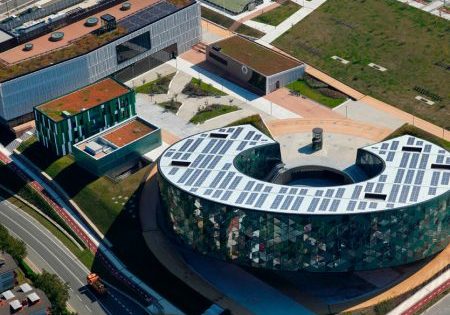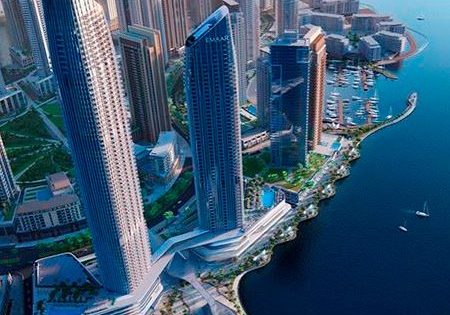Cape Town Is Rising
Nov 1, 2019

The city’s skyline rarely changes, but the new Zero2One tower is set to shake things up.
The skyline of Cape Town, a port city on South Africa’s southwest coast, is set to change in coming months as plans for the construction of the city’s tallest building solidify.
Building of the 221-m-tall Zero2One skyscraper by 2021 may be a game changer in the city’s skyline appearance, which has recorded long stretches of time between high-rise construction. This is likely a result of constrained land resources within the city, as well as the approval process for the erection of new housing structures by the City of Cape Town, a metropolitan municipality that governs the city and its suburbs and exurbs.
For example, the approval for the construction of the US$98-million Zero2One skyscraper, which is being developed by FWJK and designed by urban designer and spatial planner GAPP Architects, has come nearly five years since the completion of the city’s current tallest building, Portside Tower, a 139-m-tall mixed-use building considered one of Africa’s most sustainable.
Portside Tower uses “LED lighting, stormwater recapture, low-embodied- energy materials and the provision of individually marked, removable and recyclable unitized façade panels,” according to Schindler South Africa, one of the leading vertical-transportation (VT) players in South Africa.
The Portside tower, which is owned by Accelerate Property Fund and FirstRand Bank Ltd., was supplied with 14 elevators by Schindler South Africa with the Schindler PORT transit management system, seven additional passenger elevators with conventional controls and two escalators, according to the company’s project reviews.
Portside Tower was completed nearly 42 years after the completion of 126-m-tall 1 Thibault Square, which had reigned as the tallest building in the city since 1972. Although it is not confirmed exactly why the construction of new tall buildings takes so long before they come online, Cape Town is one of the urban centers in South Africa with acute land shortages for development of residential and commercial housing infrastructure.
The municipality previously said it needs an estimated 4,000 ha to construct housing structures for at least 400,000 residents. The 44-story Zero2One, which has been considered a solution to the city’s residential and commercial space shortages, is a mixed-use building located on the corner of Strand and Adderley streets in Cape Town’s CBD, with 570 luxury apartments and 7,000 m2 of retail shops on ground level.
A report on the proposed Zero2One tower by the City of Cape Town said:
“The proposed residential development supports the city’s desire to increase residential density within the CBD, and its location, adjacent to the Cape Town Railway Station, is ideally situated to support the ‘Transit-Oriented Development’ projects currently being encouraged by the city.”
For a long time, Cape Town’s high-rise buildings were below 142 m, with Portside Tower, completed in 2014, being the tallest. In addition to Portside Tower and 1 Thibault Square, other buildings that held the title of tallest building in Cape Town include the 119-m-tall Metlife Centre, completed in 1993; Atterbury House at 119 m; and the 117-m-tall Foreshore Place residential building.
City of Cape Town officials have bemoaned the long stretches of lack of investment in tall buildings since the development of the Victoria & Alfred Waterfront, a “working harbor” that attracts 24 million visitors annually.
The project approval report by the City of Cape Town said:
“The successful development of the Waterfront and subsequent development trends over the past 20 years have left this area struggling to attract investments and in need of regeneration, and, consequently, the project has been earmarked as one both capable of providing the much-needed residential opportunities in the city and also with ability to be a catalyst in the urban renewal of this area of the city.”
According to FWJK Development, Zero2One, which was mooted in 2016, will provide some of the most astounding 360° views in Cape Town, with the building topped by a viewing deck. “The building is ‘lifted’ off the ground in order to create safe, open and protected walkways at grade, which allows access at various points along the building edge for pedestrians, thereby activating the building and urban streetscape,” FWJK said.
FWJK CEO David Williams-Jones previously said the development of the Zero2One project had been delayed because of challenges in getting approval for foreign financing for the building and the insistence of the Cape Town city council on the inclusion of a residential housing component in the skyscraper. “The procurement of project funding has faced headwinds and has had to be secured through foreign direct investment,” Williams-Jones said during an interview with South African media in June.
Williams-Jones continued:
“Raising property development finance of ZAR1 billion (US$68 million) to undertake the project through conventional South Africa banking sources has proved impossible due to the current state of the economy and cautious bank appetite at the present time to lend on projects of this scale. Once the South African Reserve Bank approval of the foreign funding has been processed, we are targeting to commence construction works onsite within the next three to four months, bringing with it the added benefit of 3,000 new on- and offsite jobs being created.”
When the proposed Zero2One skyscraper is completed and with the likelihood Cape Town will take a few more years before a similar building is developed, the VT market in the city is likely to be sustained by the repair and maintenance segment, as owners of existing buildings either upgrade to higher-speed elevators, or maintain current elevators and escalators to ensure safe and habitable residential and commercial spaces.
South Africa in general, and the city of Cape Town, in particular, would not only benefit from the residential and commercial space opportunities expected to be provided once the Zero2One skyscraper comes online, but the country’s VT industry would have created yet another opportunity for the supply and installation of new elevator and escalator technological innovations that suit increasing demand for sustainable buildings that come in various forms and shapes.
Get more of Elevator World. Sign up for our free e-newsletter.








